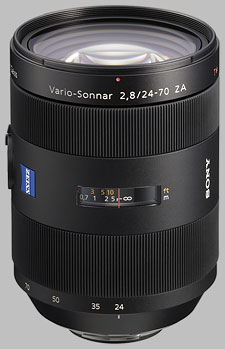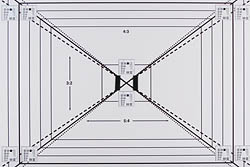| 24-70mm |
$1,800 average price |
|---|---|

|
|
Lab Test Results
Your purchases support this site
Buy the Sony 24-70mm f/2.8 ZA Carl Zeiss Vario-Sonnar T* SAL-2470Z
SLRgear Review
April 30, 2008
by Andrew Alexander
Announced on January 30, 2008, the 24-70mm ƒ/2.8 was the first glimmer of Sony's plans to release a full-frame digital SLR, as the lens is full-frame compatible. The lens seems to be Sony's opening salvo to court users of competing SLR systems: it's the second zoom lens in Sony's current line that bears the Carl Zeiss designation, the first being the 16-80mm ƒ/3.5-4.5.
The 24-70mm ƒ/2.8 is available now with a street price of around $1,750. It comes standard with a petal-shaped lens hood and takes 77mm filters.
Sharpness
Let's get the praise out of the way first thing: Sony has hit a home run with this lens. Its test results for sharpness show it to be extremely sharp, competing very closely with the Canon and Nikon comparable lenses. Its is optimized to provide its sharpest results in the wider portion of its aperture range, which makes sense to me, as this is a lens you will spend a lot of time shooting wide open. If I were to pick its optimal settings for sharpness they would be 50mm at ƒ/4, but really, results are so sharp through ƒ/4 that you could select any focal length and be hard-pressed to tell the difference.
Remarking on the lens' quality at ƒ/4 shouldn't be interpreted as suggesting its performance at ƒ/2.8 is lacking - far from it. At 24mm and ƒ/2.8, there is a very nice sweet spot of sharpness in the majority of the frame, with a hint of softness in the extreme corners (2 blur units). At 35mm the image is tack-sharp at ƒ/2.8, at 50mm it's just a bit less sharp, but at 70mm the sweet spot is less sweet with 2-3 blur units on average throughout the frame.
As mentioned, stopping down to ƒ/4 will get you the sharpest possible images from this lens, and things only get marginally less sharp between ƒ/5.6-ƒ/11 (the frame doesn't exceed 2 blur units anywhere). Diffraction limiting sets in at ƒ/16, but still, we're just seeing a generalized increase in softness - it still doesn't exceed 2 units. It's only at ƒ/22 that it exceeds 2 units, but doesn't hit 3.
In summary, just exquisite performance for sharpness.
Chromatic Aberration
The 24-70mm ƒ/2.8 offers outstanding resistance to chromatic aberration. If you peeped very, very closely at 24mm or 70mm, you might detect some CA in the extreme corners - though it could easily be overlooked. Between 35-50mm, CA is statistically insignificant. The Carl Zeiss T* coating would appear to be doing its job very well.
Shading (''Vignetting'')
The lens has no issues at all with corner shading, providing an almost-uniform delivery of light across the entire frame. I have to say ''almost'' because according to our tests, at 24mm (regardless of aperture) we detect a quarter-stop of light falloff in the corners. At other focal lengths, light falloff in the corners is less than that.
Distortion
The 24-70mm handles distortion very well - slightly barrel-distorted on the wide end, and slightly pincushioned on the telephoto end. At around 35mm, distortion is neutral and straight lines appear straight.
Wide-angle distortion manifests below 35mm, and at its widest point the distortion effect isn't too significant, showing as 0.5% in the corners and half that elsewhere. It's simple distortion that can be corrected easily in post-processing software. After 35mm, distortion transforms into the pincushion style, reaching -0.2% in the corners at 70mm. However, average distortion (in the middle of the image) is just slightly barrel-distorted (
Autofocus Operation
With its new SSM (Super Sonic wave Motor) technology, Sony enters the same style of silent, rapid focusing enjoyed by other camera manufacturers. The 24-70mm focuses very quickly, and almost noiselessly. A button on the side of the lens barrel allows a focus lock operation, whereby the user can autofocus, press the button, and release the shutter button. When the shutter button is pressed again, the focus point is maintained. It it possible to achieve this same effect by just selecting manual focus after autofocusing, but having a button there means you don't have to move your hand away from its rest position on the lens to achieve the same end.
Macro
Close-up operation is average, with a magnification ratio of 0.25x and a minimum close-focusing distance of 34cm (13'').
Build Quality and Handling
As a premium lens, Sony has pulled out the stops on this one. It's heavy - 955 grams (33.3 oz), which makes it a bit front-heavy on our A700 test body. The lens mount is metal. The build quality of the lens is superb, with an all-black finish. I would characterize the texture of the lens as ''slick'' rather than rugged, but this goes hand-in-hand with the finish of the A700, I suppose. The 24-70mm features a recessed and windowed distance scale marked in feet and meters, as well as the aforementioned focus lock button. Surrounding the focus lock button is a manual / auto focus selector switch, which deactivates autofocus operation on the lens.
The lens extends slightly while zooming, and at 70mm the lens has extended 1 5/8''. The petal-shaped lens hood adds an additional 1 3/4'' to overall lens length. The zoom ring is an inch wide, with the same raised rubber ridge texture on its other lens offerings. The ring is nicely damped, offering a very smooth turn - it takes a little less than a quarter-turn to go through the focal range. There's no evidence of zoom creep during regular operations.
The focus ring is slightly slimmer than the zoom ring (3/4'') and has the same raised rubber ridge texture as the zoom ring. The focus ring travels about a quarter-turn through its range, and offers excellent smooth control over manual focus. The front filter ring doesn't rotate during zooming or focusing, as you would expect from a lens of this caliber. The front filter ring is plastic, rather than metal. Whether this is an advantage or a disadvantage depends on your attitude towards plastic filter rings.
Alternatives
Konica Minolta 28-70mm ƒ/2.8 G AF ~$1200
Konica-Minolta produced a 28-70mm ƒ/2.8, but finding a copy could be a challenge now.
Sigma 24-70mm ƒ/2.8 EX DG Macro ~$400
We haven't tested the Sigma comparable, but it's also a 35mm full-frame lens offering that's thought highly of in our user reviews. This version is not HSM, so it will be slower to focus and noisier, too. However, it's much less expensive.
Tamron 28-75mm ƒ/2.8 XR Di LD Aspherical IF SP AF ~$360
Our test of the Tamron 28-75mm ƒ/2.8 showed excellent results, slightly less sharp and prone to just slightly more CA than the Sony, but offering comparable performance for distortion and corner darkening. Konica-Minolta also offered a 28-75mm ƒ/2.8 with the exact same specifications, suggesting it was a rebranded Tamron. These lenses focus mechanically, so they'll be slower and noisier to focus, but they are also 35mm full-frame compatible, and sport an aperture ring.
Tokina 28-70mm ƒ/2.8 AT-X 287 AF PRO SV ~$250
Tokina also offers a constant ƒ/2.8 lens with a similar focal length, but we haven't tested it. If you're desperate to get a focal range with a constant ƒ/2.8 aperture, but can only dream of the Sony because of its price tag, this could be an option.
Conclusion
I'm not one to gush, but there's really only one way to end this review - with glowing praise. The Sony 24-70mm ƒ/2.8 offers truly exquisite optical performance, and mounted on an Alpha body with in-camera image stabilization, you're looking at a truly remarkable platform for creating excellent images. If you think you need this lens and can afford it, it's a very easy decision to make.
Sample Photos
The VFA target should give you a good idea of sharpness in the center and corners, as well as some idea of the extent of barrel or pincushion distortion and chromatic aberration, while the Still Life subject may help in judging contrast and color. We shoot both images using the default JPEG settings and manual white balance of our test bodies, so the images should be quite consistent from lens to lens.
As appropriate, we shoot these with both full-frame and sub-frame bodies, at a range of focal lengths, and at both maximum aperture and ƒ/8. For the ''VFA'' target (the viewfinder accuracy target from Imaging Resource), we also provide sample crops from the center and upper-left corner of each shot, so you can quickly get a sense of relative sharpness, without having to download and inspect the full-res images. To avoid space limitations with the layout of our review pages, indexes to the test shots launch in separate windows.
Sony 24-70mm f/2.8 ZA Carl Zeiss Vario-Sonnar T* SAL-2470Z
Your purchases support this site
Sony A-mount - Black
Sony 24-70mm f/2.8 ZA Carl Zeiss Vario-Sonnar T* SAL-2470Z User Reviews
-
super fast SSM, better IQ over all IQ than the Canon and the Nikon 24-70.a bit too bulky , a bit too heavy, scratch prone barrel design , poor flare resistance
only one con of it is its poor flare perfromance.
reviewed November 15th, 2010
it is the sharpest and best 24-70f2.8 of any kind and it is stabilized.
it is much better corrected than both the Canon and the Nikon 24-70 at 24-35mm range.
it has faster SSM than the Nikon SWM in the 24-70 Nikkor.
it also comes witha good qaultiy metal hood.
I love this lens , it is a very good lens on the A900.
oh almost forgot to write about this , its center resolution is probably exceeding all primes in its range.
and its bokeh at 70mm is creamy , better than many primes actually.
Highly recommended. -
Excellent IQ contrast 3D, all the Zeiss goodiesHuge, heavy, front extends through zooming, field curvature at WA
Excellent sharpness overall but corners can be sometimes problematic due to field curvature. Curiously there is very little to no curvature beyond 35mm FL. An excellent standard zoom.
reviewed August 20th, 2010 (purchased for $1,800)









